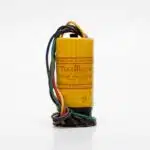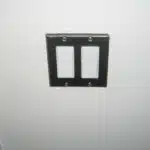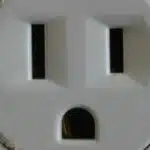Replacing a single-pole wall switch is a common electrical task that can be accomplished with ease by anyone with basic knowledge of electrical wiring. This task involves disconnecting the existing switch from the power source and replacing it with a new switch. The process requires attention to detail and adherence to safety guidelines to avoid injury or damage to the electrical circuit.
As an electrician or electrical engineer, it is crucial to have a solid understanding of how switches work and how they can be safely replaced. In this article, we will guide you through the step-by-step process of replacing a single-pole wall switch, providing you with all the necessary information and tips needed for a successful project. Whether you are an experienced professional or just starting out in your career, this article will provide you with valuable insights into one of the most essential tasks in residential electrical installation and repair. So let’s get started!
Understanding Electrical Wiring Basics
Electrical safety is of utmost importance when dealing with electrical wiring. It is imperative to observe all the necessary precautions to avoid accidents and damages. Before doing any work on your electrical system, make sure that the power supply is turned off. This can be done by switching off the circuit breaker or removing the fuse from its holder.
In addition to observing electrical safety, it is important to adhere to wiring regulations. These regulations are in place to ensure that electrical installations are safe and efficient. One of the key aspects of wiring regulations involves using appropriate cables for specific circuits. This ensures that the cable can handle the load safely without overheating or causing a fire.
When replacing a single-pole wall switch, it is crucial to identify the type of switch you are working with. The single-pole wall switch is one of the most commonly used switches in households and commercial buildings. It is used to control lights and other electrical devices in a room from a single location. Identifying this type of switch will help you determine how best to proceed with replacing it, which we will cover in subsequent sections.
Identifying A Single-Pole Wall Switch
Wall switches are commonly found in residential and commercial buildings and range from single-pole switches to multi-pole switches. Single-pole switches are typically identifiable by their single toggle and single input wire, as opposed to multi-pole switches which have multiple toggles and multiple input wires. To identify a single-pole switch, one should look for a toggle switch with one input wire. After identifying a single-pole switch, one should test the switch for functionality by turning off the power, unscrewing the switch, and connecting one of the two wires to the common terminal. If the switch is working correctly, the light should turn off.
Types Of Wall Switches
When identifying a single-pole wall switch, it is important to differentiate between rocker and toggle switches. A toggle switch is the traditional type of wall switch, characterized by a lever that can be flipped up or down. On the other hand, a rocker switch has a flat surface that can be pressed on one side or the other to turn the lights on and off. While both types of switches perform the same function, they have different aesthetics and may require slightly different installation methods.
Another type of wall switch is the dimmer switch. Dimmer switches are designed to allow you to adjust the brightness of your lights by turning a knob or sliding a lever. They are particularly useful in rooms where you want to create mood lighting or control the level of light based on time of day. However, installing dimmer switches requires some knowledge of electrical wiring and may not be suitable for DIY projects. It is important to consult with an electrician before attempting to install dimmer switches.
Understanding the different types of wall switches available in the market can help you make informed decisions when replacing your single-pole wall switch. Whether you choose between a rocker or toggle switch or decide to install dimmer switches, it is important to prioritize safety when working with electricity. Always turn off power at the circuit breaker before starting any electrical work and if unsure about anything, consult with a professional electrician for guidance.
Identifying A Single-Pole Switch
Identifying a single-pole wall switch is an essential skill for anyone dealing with household electrical systems. A single-pole switch is the most basic type of light switch and is used to control the flow of electricity to a single lighting fixture or appliance. It has two terminals, one for the incoming hot wire and another for the outgoing load wire. While it may seem like a simple task, identifying a single-pole switch can be challenging if you’re not familiar with electrical wiring.
Common mistakes when identifying a single-pole switch include confusing it with other types of switches, such as three-way or four-way switches. Three-way switches are used in situations where you want to control a light from two different locations, while four-way switches are used in setups with three or more switches controlling the same light fixture. Troubleshooting tips when identifying a single-pole switch involve turning off power at the circuit breaker before attempting any work and using a voltage tester to verify that no wires are live.
To identify a single-pole wall switch, you need to locate it first. Single-pole switches are typically found near entry doorways or on staircases where they can be easily accessed. Once located, determine whether it’s a toggle or rocker switch by flipping it up and down or pressing on either side of the flat surface. You can also take note of any labels on the switch that indicate whether it’s part of a larger circuit, such as “living room lights.” By following these steps and avoiding common mistakes and troubleshooting tips, identifying a single-pole wall switch can be done safely and efficiently.
Testing A Single-Pole Switch
After successfully identifying a single-pole wall switch, the next step is to test its functionality. Testing a single-pole switch is crucial in ensuring that it works correctly and that there are no faulty wirings. Before testing, it is essential to turn off power at the circuit breaker to avoid any electrical accidents.
To test a single-pole switch, use a voltage tester to check if both terminals of the switch have no live wires. Attach one end of the tester to the hot wire terminal and the other end to a neutral wire. If the tester does not light up, this means that there is no current flow in the circuit and that the switch is functioning correctly. On the other hand, if the tester lights up, it indicates that there is an issue with either wiring or connections.
If you encounter faulty wiring detection during testing, it is crucial to address them immediately before using your lighting fixture or appliance. You can start by checking for loose connections or damaged wires around your switch box. If necessary, call an experienced electrician to help you locate and fix any faulty wirings effectively. Remember that safety should always be your top priority when dealing with electrical systems at home.
Preparing For The Replacement Process
After identifying the single-pole wall switch, the next step is to prepare for the replacement process. Before doing anything, it is important to gather all necessary tools needed for the job. These tools include a flathead screwdriver, a Phillips-head screwdriver, wire strippers, and a voltage tester. It is also important to purchase a new single-pole wall switch that matches the specifications of the old one.
Safety precautions must be taken before starting any electrical work. Turning off the power source is crucial to avoid electrocution or damage to electrical components. To do this, locate the circuit breaker box and turn off the corresponding switch that controls the power supply to the room where you will be working. Afterward, use a voltage tester on both sides of the switch to make sure that there is no more electrical current flowing through it.
Once you have made sure that there is no more electrical current flowing through the circuit, you can proceed with replacing your single-pole wall switch. Prepare your tools and follow proper safety precautions before starting any electrical work in your home or office. With these steps in mind, replacing your single-pole wall switch should be smooth and easy.
Turning Off The Power Source
To ensure a safe and effective replacement of a single-pole wall switch, it is imperative to turn off the power source. This step cannot be overlooked as it can lead to serious injury or even death if not properly executed. Therefore, it is crucial to understand the importance of safety and the proper equipment needed for turning off the power source.
Firstly, safety should always be the top priority when working with electricity. Before beginning any electrical work, make sure to turn off the power source at the circuit breaker. This will prevent any accidental electrocution while working on the switch. Additionally, wearing rubber-soled shoes and gloves will further reduce the risk of electrical shock.
Furthermore, using proper equipment for turning off the power source is essential for ensuring safety. A non-contact voltage tester can be used to verify that no voltage is present before starting work on the switch. It is also critical to use insulated tools such as pliers or screwdrivers to avoid contact with live wires.
- Always wear protective gear such as safety goggles and gloves.
- Make sure all electrical devices are switched off before performing any repairs.
- Never touch exposed wiring without proper insulation.
- Have a fire extinguisher nearby in case of an emergency.
With safety in mind and proper equipment at hand, you can now confidently turn off your power source and prepare for replacing your single-pole wall switch. The next step in this process involves removing the switch plate cover so that you can access the switch itself.
Removing The Switch Plate Cover
After turning off the power source, the next step in replacing a single-pole wall switch is to remove the switch plate cover. To do this, you must first locate and remove the screws that hold the cover onto the wall. These screws are typically located at the top and bottom of the cover, but may also be found on either side depending on the design of your switch.
Once you have removed the screws, gently pull the switch plate cover away from the wall to reveal the wiring behind it. Take care not to pull too hard or damage any wires that may be present. You should now see two or more wires attached to your old switch. Depending on how your old switch was wired, these wires may be connected using screws or wire nuts.
Before handling any wires, double-check that you have turned off power to your switch by using a voltage tester. Once you have confirmed that there is no electrical current running through your switch, proceed with disconnecting the old switch from its wiring.
Disconnecting The Old Switch
To begin disconnecting the old switch, turn off the circuit breaker that controls the switch. This is crucial for safety reasons and to avoid any electrical hazards. Use a voltage tester to double-check and make sure there is no power flowing through the wires connected to the switch.
Once you have confirmed that there is no electricity running in the wires, carefully remove the faceplate of the switch. Unscrew the screws holding the switch in place and gently pull it out from its position on the wall. Be cautious not to touch any of the wires while doing this, as they may still carry an electric current.
After removing the old switch, properly dispose of it according to local regulations. Switches contain materials that can be hazardous if not disposed of correctly. Make sure to handle it with care and take it to a designated disposal site or contact a professional service for proper disposal methods. With this step completed, you can now move onto connecting your new switch.
Connecting The New Switch
Symbolism: The moment of truth arrives as you prepare to connect the new switch. The wires are like puzzle pieces, waiting to be pieced together with precision and care. As an electrician or electrical engineer, you know that proper wire connections and grounding techniques are crucial for a safe and functional electrical system.
To ensure a successful switch replacement, follow these steps:
- Turn off the power supply to the switch at the circuit breaker box.
- Carefully remove the wires from the old switch. Take note of which wire is connected to each screw terminal.
- Connect the wires to the corresponding screw terminals on the new switch. Use wire nuts to secure any bare wire ends.
Grounding techniques are essential for preventing electrical shock and fire hazards. When connecting your new switch, make sure that any green or bare copper wires are securely attached to a grounding screw or clip on the switch. If your wiring does not include a ground wire, consult a professional electrician for guidance on how to safely install your new switch.
As you finish connecting your new switch, take a moment to double-check all of your wire connections and make sure they are tight and secure. With this step completed, you’re ready to move on to attaching the switch plate cover and finishing up your project with confidence.
Attaching The Switch Plate Cover
The switch plate cover must be securely attached to the wall. It should be gently secured using the two anchor screws provided. The screws should be driven into the wall studs for a secure fit. Careful attention should be taken to ensure the screws are driven in evenly and to the correct depth.
Gently Secure Plate
When it comes to wall switch aesthetics, a properly installed switch plate cover can make a big difference. Attaching the switch plate cover is the final step in replacing a single-pole wall switch. One important aspect of this step is to gently secure the plate to avoid damaging it or the surrounding wall.
There are several plate fastening techniques available, including screws, adhesive tape, and magnets. However, regardless of the method used, it’s crucial to handle the plate with care. Applying too much pressure or using excessive force can cause cracks or chips in the cover or damage to the surrounding drywall.
To avoid these issues, start by aligning the plate with the switch and carefully screwing it into place. If using adhesive tape or magnets, ensure that they are strong enough to hold the cover securely without causing damage over time. Remember that when attaching a switch plate cover, every detail matters for both functionality and aesthetics.
In conclusion, attaching a switch plate cover may seem like a minor detail in replacing a single-pole wall switch; however, it’s an essential part of ensuring proper functionality and maintaining wall-switch aesthetics. Therefore, electricians and electrical engineers should always use gentle techniques when securing plates to avoid any damages to either covers or surrounding walls while keeping in mind different fastening techniques available for optimal results.
Anchor Screws
When attaching a switch plate cover, choosing appropriate anchor screws is crucial to ensure that the plate is securely fastened to the wall. Different types of anchor screws are available for single pole wall switches, and electricians should choose the one that suits their specific needs. Anchor screws come in different sizes and shapes, and some are more suitable for certain types of walls than others.
One type of anchor screw commonly used for switch plates is the plastic expansion anchor. This type of anchor has a sleeve that expands as the screw is tightened, providing a secure hold on drywall or plaster walls. Another option is the metal toggle bolt anchor, which has two wings that open up behind the wall when inserted, providing a strong hold on thicker walls or hollow spaces.
When choosing an anchor screw for a switch plate cover, it’s important to consider the weight of the cover and how much force will be applied to it over time. The wrong type of anchor screw can cause damage to both the cover and the surrounding wall if it fails to hold properly. Therefore, electricians should always use high-quality screws from reputable manufacturers and follow recommended installation procedures to ensure optimal performance.
In summary, choosing appropriate anchor screws is an essential aspect of attaching a switch plate cover for single pole wall switches. Electricians should carefully evaluate their options based on factors such as wall type and cover weight before selecting a suitable solution. By using high-quality screws and following recommended installation procedures, they can ensure long-term functionality and aesthetics while avoiding potential damages to both covers and surrounding walls.
Turning The Power Back On
After attaching the switch plate cover, it’s time to turn the power back on. However, before doing so, it is essential to take safety precautions. Make sure that all electrical wires are properly connected and secured. Inspect the wiring connections for any signs of wear and tear or damage.
Once you are certain that everything is in place, it’s time to restore power. Go to your home’s main circuit breaker box, locate the switch that controls the power supply for the room where you installed the new switch, and flip it back on. This will restore power to your newly installed switch.
It is important to note that just because you have restored power does not mean that everything is working correctly yet. The next step is to test your new switch to ensure that it is functioning correctly.
Testing The New Switch
Metaphorically speaking, installing a new single-pole wall switch is like replacing a worn-out tire on your car. Just like how a faulty tire can cause problems with your vehicle’s performance, a malfunctioning switch can disrupt the flow of electricity in your home. Therefore, it’s essential to test the new switch before completing the installation process.
Testing techniques for a single-pole wall switch involve turning off the circuit breaker, removing the old switch, and attaching the wires onto the new one. Once everything is in place, turn on the power and check if the light turns on or off when using the switch. Additionally, you can use a multimeter to measure voltage levels and ensure that everything is working correctly.
Safety measures should always be taken when testing electrical components. Turn off all power sources before proceeding with any testing procedures. It’s also essential to wear insulated gloves and avoid touching any exposed wires or metal parts while performing tests.
To summarize, testing a new single-pole wall switch involves following specific techniques and safety measures to ensure that everything is working correctly. By taking these precautions and using proper testing methods such as checking voltage levels and verifying that lights turn on or off when using switches, you can identify any potential issues early on and prevent future problems from occurring.
Next up: Troubleshooting common issues with single-pole wall switches.
Troubleshooting Common Issues
Common mistakes can occur during the process of replacing a single-pole wall switch. One of the most common mistakes is forgetting to turn off the power supply before beginning the replacement. This can lead to dangerous electrical shocks and should be avoided at all costs.
Another common issue that arises is wiring errors. It’s crucial to understand the wiring diagram provided with the new switch and ensure that each wire is correctly placed in its designated terminal. A miswiring can lead to issues such as a non-functional switch or even short circuits, which can cause significant damage.
If you encounter any problems while replacing your single-pole wall switch, there are several troubleshooting tips you can try. First, double-check your wiring connections to make sure they are secure and correctly placed in their terminals. If this doesn’t work, check your power supply and make sure it’s turned on. Finally, if none of these steps work, it may be time to consult with an electrician who has experience in this area.
Ensuring safety during the process of replacing a single-pole wall switch is critical. Always remember to turn off the power supply before starting any work on your electrical system, wear protective gear such as gloves and goggles if necessary, and never attempt any repairs beyond your skill level. By following these guidelines, you’ll not only avoid potential hazards but also ensure proper function of your new switch for years to come.
Ensuring Safety During The Process
After troubleshooting common issues with single-pole wall switches, it’s time to replace them. However, before starting the process of replacing a switch, assessing risks and taking safety precautions is crucial. Electrical work can be hazardous if not handled properly, and it’s important to keep yourself and others safe.
Assessing risks involves identifying potential hazards that may arise during the replacement process. This could include exposed wires, outdated wiring systems or electrical boxes that are not properly grounded. Once you have identified these risks, you can take steps to minimize them by turning off the power supply to the switch at the circuit breaker box and wearing protective gear like gloves and safety glasses.
Safety precautions must also be taken when replacing a single-pole wall switch. These precautions include using proper tools and equipment such as wire strippers and pliers to avoid damaging wires or causing fire hazards. Additionally, following manufacturer instructions for installation procedures can ensure that the new switch is installed correctly.
Using proper tools and equipment is essential for safely replacing a single-pole wall switch. By assessing risks beforehand and taking necessary safety precautions throughout the process, you can reduce potential hazards associated with electrical work. With this in mind, it’s important to always prioritize your safety as well as those around you while performing any type of electrical repair work.
Using Proper Tools And Equipment
When it comes to replacing a single-pole wall switch, it is important to use proper tools and equipment. As the saying goes, “using the right tool for the job makes all the difference.” This holds true for electrical work as well. Choosing appropriate materials and ensuring that you have the right tools on hand can make the process much smoother and safer.
Before beginning any electrical work, it is crucial to follow safety protocols. This includes turning off the power to the circuit you will be working on and testing that there is no electricity flowing through it. Additionally, wearing protective gear such as gloves and eye protection can prevent injury in case of accidental contact with live wires.
When replacing a single-pole wall switch, having a screwdriver, wire stripper, voltage tester, and new switch on hand is essential. These tools allow you to safely disconnect and reconnect wires while ensuring that there is no live electricity present. Below is a table outlining each tool’s purpose in this process:
| Tool | Purpose |
|---|---|
| Screwdriver | Used to loosen/tighten screws holding wires in place |
| Wire Stripper | Removes insulation from wires for connection |
| Voltage Tester | Ensures there is no live electricity |
| New Switch | Replaces old switch with new one |
Remember that even with proper equipment and following safety protocols, electrical work can still be dangerous. If at any point you feel unsure or uncomfortable with what you are doing, seek professional help. It is always better to err on the side of caution when dealing with electricity. In the next section, we will discuss when it may be necessary to seek professional assistance with your electrical needs.
Seeking Professional Help When Needed
While replacing a single-pole wall switch may seem like a simple task, there are certain instances where it is necessary to seek professional help. One of the benefits of DIY electrical work is that it can save you money, but it is important to weigh this against the risks and potential costs of making mistakes. If you have any doubts about your ability to safely complete the project, or if you encounter unexpected difficulties during installation, it is best to stop and consult with an electrician.
When seeking out a qualified electrician, there are several tips to keep in mind. First, make sure that the electrician is licensed and insured. This will protect you in case anything goes wrong during the job. Additionally, ask for references and check online reviews to ensure that the electrician has a good reputation for quality workmanship and customer service. Finally, discuss pricing and timing upfront so that there are no surprises when it comes time to pay.
Overall, while some electrical projects can be done on your own, it is important to know your limits and seek professional help when needed. By doing so, you can avoid costly mistakes and ensure that your home’s electrical systems are safe and functioning properly. In the next section, we will discuss tips for maintaining electrical systems for longevity.
Maintaining Electrical Systems For Longevity
Electrical maintenance is a crucial aspect of maintaining the longevity of your electrical systems. Regularly inspecting and maintaining your systems ensures that they remain in good condition, minimizing the risk of electrical faults and accidents. It is important to note that electricity is dangerous and should be handled with care. Therefore, it is essential to hire a professional electrician or electrical engineer to conduct regular maintenance checks.
One of the essential longevity strategies for maintaining electrical systems is to ensure that all electrical components are installed correctly. Faulty installations can lead to short circuits, overheating, and other issues that compromise the safety of your home or business. It is also vital to use high-quality materials when installing electrical systems as inferior products can be hazardous.
Another critical aspect of maintaining your electrical systems’ longevity is by conducting regular inspections and necessary repairs promptly. Any signs of wear and tear should be addressed immediately to prevent further damage or potential hazards. Electrical maintenance tips such as checking for frayed wires, loose connections, and damaged outlets should be conducted regularly. Moreover, it is advisable to have a professional electrician assess the system periodically to ensure it’s functioning optimally.
In summary, investing in proper electrical maintenance services helps prevent emergency situations while increasing efficiency in power usage. Longevity strategies such as using quality materials during installation, conducting regular inspections, and addressing necessary repairs promptly are vital for preventing premature failure of equipment and ensuring safety at all times. Therefore, always seek professional help from qualified electricians or engineers who possess the knowledge and experience required for proper handling of any electrical issues that may arise in your home or business premises.
Conclusion
Understanding electrical wiring basics is crucial when it comes to replacing a single-pole wall switch. It is important to identify the switch and prepare for the replacement process by turning off the power source and removing the switch plate cover. Safety should always be a top priority during this process, and proper tools and equipment must be used.
However, it is important to note that not everyone may feel comfortable with electrical work. Seeking professional help when needed is always an option to ensure that the job is done correctly and safely. Additionally, maintaining electrical systems properly can also extend their longevity.
As electricians or electrical engineers, we understand the importance of safety when dealing with electricity. By following proper procedures and using appropriate tools, we can ensure that any replacement processes are done correctly while minimizing risks. Remembering to seek professional help when necessary can save time, money, and even lives in some cases. Regular maintenance can also prevent future issues from arising, ultimately extending the lifespan of your electrical systems.
Image Credits
- “‘… All in all it’s just another [switch] in the wall.’ …” by grytr (featured)

![How To Replace A Single-Pole Wall Switch 1 '... All in all it's just another [switch] in the wall.' ...](https://green-life.blog/wp-content/uploads/2023/05/17xmP5qMtVjq.jpg.webp)



























